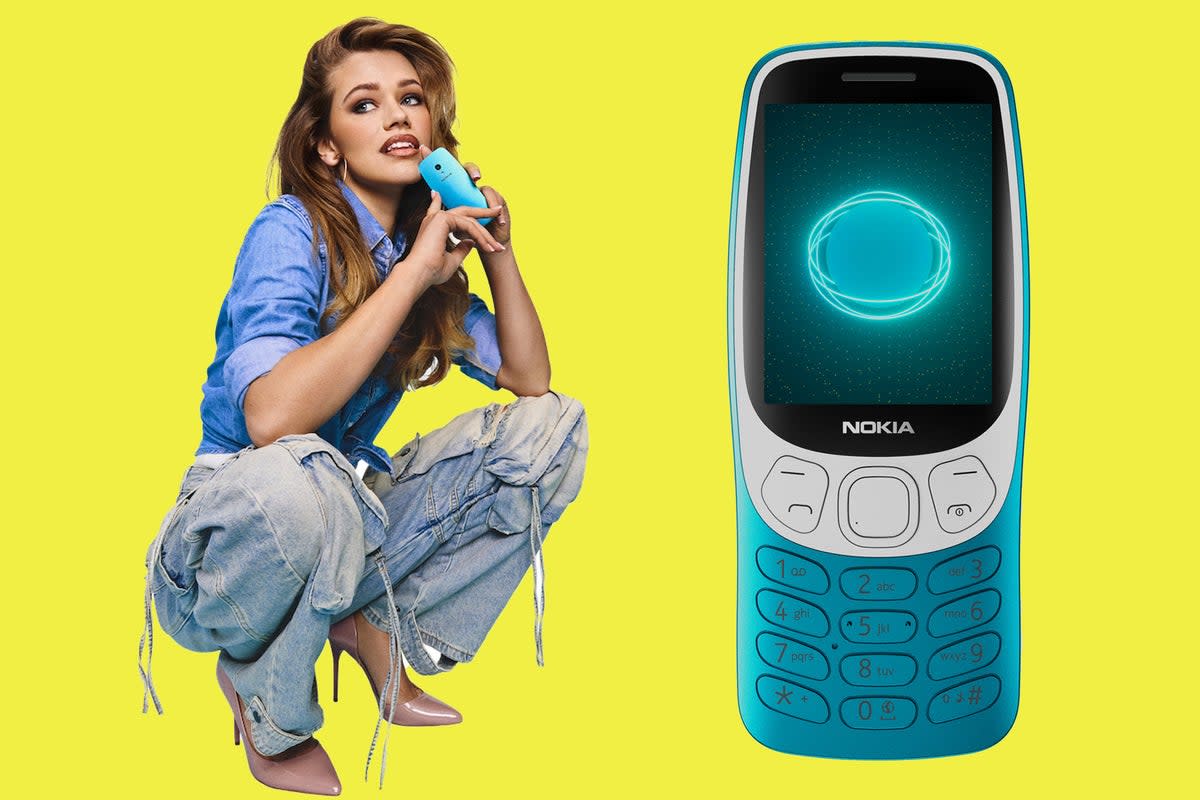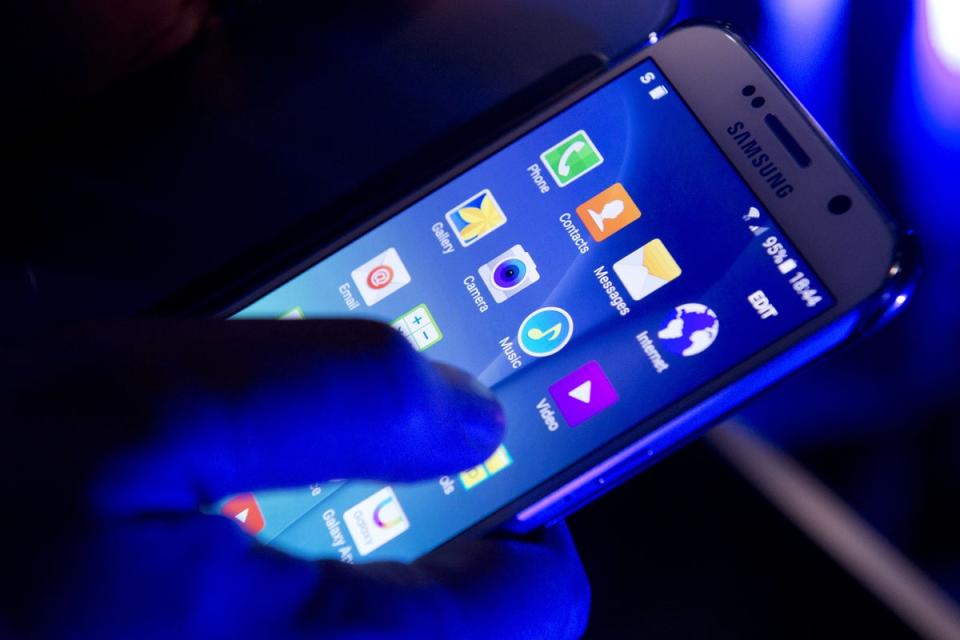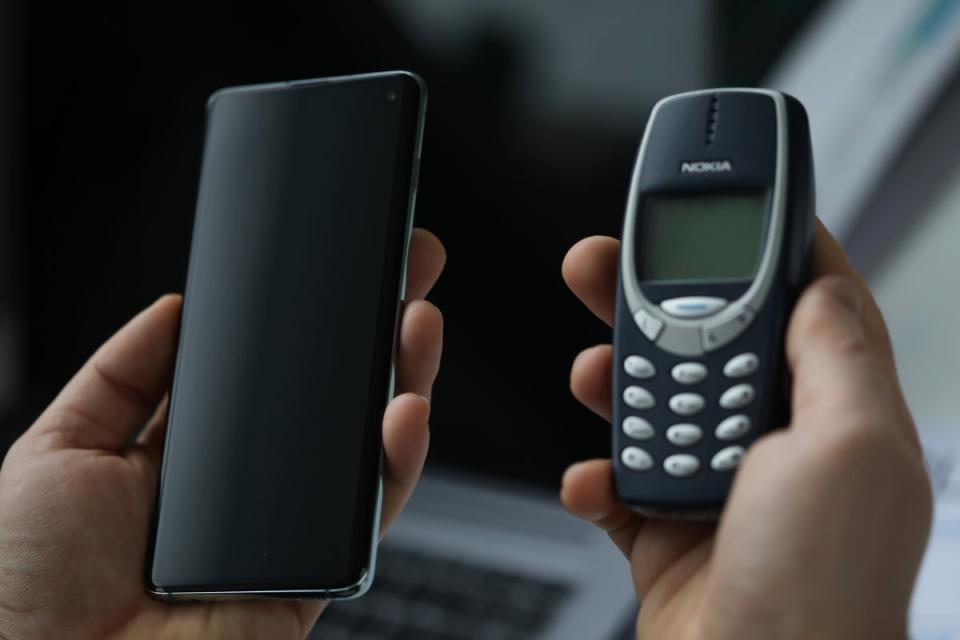I didn’t grow up with smartphones – will going back to a Nokia 3210 simplify my life?

Nu phone, who dis?”
It’s a phrase I expected to be typing out with nostalgic joy – for the first time in two decades – as I switched on the new and improved Nokia 3210. Twenty-five years after its original heyday, the iconic mobile phone of my youth has had a relaunch for 2024 – a savvy response to a rising backlash against the insidious side effects of heavy smartphone use. Alas, I waited in vain: to be able to send such a pithy response, I’d have first had to receive a text message. But no one – not even my 72-year-old mother – sends text messages anymore. They use WhatsApp.
It’s just one of a vast number of examples of how every facet of life has adapted to revolve around devices in the smartphone era. And it doesn’t take long to realise that there’s not one inch of my existence that isn’t, in some way, facilitated by a palm-sized screen: my work, my social life, my love life, my travel, my finances.
In times gone by, I always proudly identified as “an analogue girl” (largely because it sounded cuter than “luddite technophobe weirdo”). I preferred books to Kindles, had an honest-to-goodness Filofax as my diary, and continued to use a physical bank card to pay for stuff. I was such a late adopter that most people had gone on to a much cooler digital after-party by the time I arrived.
I still remember drawing maps on scraps of paper whenever I had to reach a new destination, because paying extra for data seemed an extravagant waste of cash; still remember a friend once swiping left on my smartphone to find an empty screen and asking in breathless horror: “Where are all your apps??”
Cut to 2024 and, while I’m still a far cry from an early adopter, my stubborn resistance to tech has been no match for our overwhelmingly online society. I’m as pathetically addicted as the next digital junkie.
According to 2023 research from DataReportal, the average screen time for users around the world aged 16 to 64 is six hours 37 minutes a day, three hours and 46 minutes of which is accounted for by smartphone use. UK adults spend the equivalent of 56 days a year online, says Ofcom research, while my millennial demographic boasts the highest number of apps of any age group, averaging 41. Again, the “analogue girl” of old would be appalled: I currently have a grand total of 43 (not including the built-in ones my phone came with).

Lately, I’ve been feeling increasingly uncomfortable about the ease with which I’ve slid into this “new normal” – a life orbiting around the device in my pocket. Recent research linking a mental health crisis in children and young people with the rise of the smartphone makes for alarming reading; admissions from those who developed social media platforms acknowledging that they created a monster provide even more incentive to cut back. One tactic encouraged by campaigners, including social psychologist Jonathan Haidt, author of The Anxious Generation, is the introduction of better “basic” phones to avoid giving children smartphones. The popularity of these “dumbphones” – ones with functions such as calling, texting and setting alarms – is on the up, particularly for Gen Z, four in 10 of whom worry they spend too much time on their smartphones. They’re the only generation whose social media use has actually declined since 2021, reports The Guardian.
Suspicion around privacy, data-harvesting and manipulations to keep us endlessly scrolling have driven trends such as the #bringbackflipphones hashtag on TikTok. Meanwhile, HMD, the company behind Nokia’s relaunch, saw its flip phone sales double by April 2023. Retro tech is officially cool again.
And thus it is that I find myself jumping on the offlining bandwagon and excitedly unboxing a new 3210, the same model as my first ever mobile when I was a teenager, to see whether swapping my Samsung for this revamped brand of minimalism can help me re-engage with the real world. You pay a premium for this level of nostalgia: retailing at £74.99, it’s three times the price of the Nokia 105 dumbphone.
Things get off to a rocky start. I plug it in to charge it and nothing happens; I push the power button and zilch. After 10 minutes spent furiously trying out various sockets, unplugging and reinserting the charger, and jabbing at every single button on the phone, I finally realise the obvious – the battery isn’t in the handset yet. It’s been so long since I’ve had a phone where you physically could remove the battery that I just... forgot.
My stubborn resistance to tech has been no match for our overwhelmingly online society
Before I switch sim cards, I download WhatsApp onto my laptop – at least that way I won’t be a total social pariah – and mentally run down what else might be essential from my smartphone.
Train tickets! They’re all on the Trainline app. OK, fine, there must be a code for printing them out at the station. But no – try as I might, I cannot locate anything that would allow me to access paper versions from the ticket machine. The only analogue alternative is to print off the QR codes at home; being a millennial I, of course, don’t have a printer. Hmm. I decide I’m going to have to cheat and use my smartphone to get into London for work – I don’t think my boss would quite accept the “my burner phone ate my homework” excuse.
In more positive news, I quickly find that my new 3210 has the classic Noughties game, Snake. In fact, this is the first question everyone asks me when they see my dumbphone: “Does it have Snake?” (Well, that and whether I’ve become a drug dealer.) It’s as inexplicably compelling as I remember, although this version’s been treated to a jazzy colour upgrade and the snake is eating apples rather than dots. The game provides a welcome stand-in for what my thumbs would usually be doing: scrolling social media until my brain turns to mush.
Other useful extras include a torch, voice recorder, calculator and eight further games. The phone also has 4G internet, which I really wasn’t expecting – the quaintly basic functionality brings to mind the early days of the web, flooding my head with wistful recollections of MSN Messenger and Myspace. You can practically hear the chirrups, whistles and Matrix-like white noise of the dial-up modem tone as you click the icon. Ah, memories!

I’m currently cat-sitting for a friend and decide to try out my stripped-back mobile’s 2MP camera capabilities (a function I could have only dreamed of back in the day). The video of her beloved pets is charmingly slow-mo, the pictures slightly blurry. It’s a world away from the high-definition, crystal-clear world of my smartphone, which would capture every hair and allow me to edit my images into masterpieces. An unexpected upside of the amateur quality is that I don’t waste time filling up my digital storage with hundreds of snaps. I take two photos, look at them, shrug at how uninspiring they are, and send one to my friend. “Why are you texting me?!” she replies in consternation – a response I am soon to become all too familiar with.
It’s time to catch the train, so I grab my Bluetooth headphones for my walk to the station, only to realise I can’t use them; there’s no Spotify on my Nokia. Oh well, the sound of birdsong, cars and my own erratic thoughts it is then. On the station platform, waiting for the train, I experience that rarest of things – being present and alone in a public place with nothing to occupy me. Usually, in this brief patch of dead time, I’d be flipping between Twitter and Instagram, Slack and my work email. Now, I spend eight minutes standing in silence, looking at the trees on the other side of the platform and observing how they move in the breeze. It’s sort of weird. It’s sort of nice.
This, perhaps, is the biggest boon of going analogue. Without social media and all the rest, there’s nothing inherently addictive about a phone – it’s merely a lightweight, plastic communication tool. I spend the first few hours like any addict going cold turkey, my hand twitching to my pocket and compulsively unlocking the screen, only to realise that there are no notifications, no prompts, no apps – nothing to seize my attention and drain my time. Each time I put the device back in my pocket, feeling a mixture of despondent and oddly relieved.
As I wait for a friend to join me at the pub, I sit listening to the conversations swirling around me instead of chain-watching acquaintances’ Insta stories. Travelling the one-hour rail journey home, I open up a book instead of Netflix. My mind starts to feel less frantically connected; a helpless kind of peace descends.
It’s nigh-on impossible to put the digital genie back in the bottle
But there’s no getting around the fact that so many elements of modern life are smartphone-dependent, opting out doesn’t really feel like a viable option. Although I don’t love Instagram, it’s where I promote forthcoming gigs for my fledgling but enjoyable singing side hustle. Although I technically can access online banking via my computer, it is a much more convoluted process than using my phone, requiring passkeys and codes I can no longer remember. Although I reminisce about the days of my hand-drawn maps with a nostalgic fondness, the cold, hard reality of trying to get around without Google Maps is unbearably frustrating.
Then there’s the authentication app I need to get onto our work computer systems remotely; Uber, essential for my late-night cab needs; Dice, which has my gig tickets on it; Vinted, where I buy 90 per cent of my clothes; Railcard, without which my discounted train tickets aren’t eligible; Pray As You Go, which I use as my daily prayer practice and meditation; a ukulele tuning app, which does exactly what it says on the tin; SwiftKey, which enables me to swipe between letters to send a message within seconds... the list goes on. And on. And on.
It’s why a big part of the conversation around children and tech concerns the need to delay smartphone access for as long as possible. (St Albans, for example, has just announced its intention to become the first British city to go smartphone-free for under-14s.) Once you have one, it’s nigh-on impossible to put the digital genie back in the bottle. Our lives and systems have evolved alongside our devices; the world of paper and physical things has largely been phased out.
While I don’t think I can fully give up a smartphone, my experience has made me realise that I could strip back my apps to the essentials, consciously leave it in my bag unless I need to use it, and impose stricter rules – like not taking it out when I go for a walk or putting it in another room while I’m watching a film. Although simplifying my phone somewhat complicated my life, it did show me a glimpse of an existence where I’m less dependent on it; an existence where I can swap stimulus for stillness; and, better yet, an existence where I finally beat my 2002 high score on Snake. :-)


